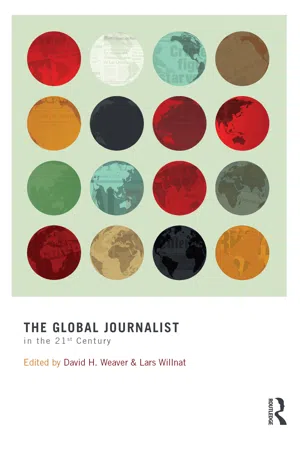
- 590 pages
- English
- ePUB (mobile friendly)
- Available on iOS & Android
The Global Journalist in the 21st Century
About this book
The Global Journalist in the 21st Century systematically assesses the demographics, education, socialization, professional attitudes and working conditions of journalists in various countries around the world. This book updates the original Global Journalist (1998) volume with new data, adding more than a dozen countries, and provides material on comparative research about journalists that will be useful to those interested in doing their own studies.
The editors put together this collection working under the assumption that journalists' backgrounds, working conditions and ideas are related to what is reported (and how it is covered) in the various news media round the world, in spite of societal and organizational constraints, and that this news coverage matters in terms of world public opinion and policies. Outstanding features include:
- Coverage of 33 nations located around the globe, based on recent surveys conducted among representative samples of local journalists
- Comprehensive analyses by well-known media scholars from each country
- A section on comparative studies of journalists
- An appendix with a collection of survey questions used in various nations to question journalists
As the most comprehensive and reliable source on journalists around the world, The Global Journalist will serve as the primary source for evaluating the state of journalism. As such, it promises to become a standard reference among journalism, media, and communication students and researchers around the world.
Frequently asked questions
- Essential is ideal for learners and professionals who enjoy exploring a wide range of subjects. Access the Essential Library with 800,000+ trusted titles and best-sellers across business, personal growth, and the humanities. Includes unlimited reading time and Standard Read Aloud voice.
- Complete: Perfect for advanced learners and researchers needing full, unrestricted access. Unlock 1.4M+ books across hundreds of subjects, including academic and specialized titles. The Complete Plan also includes advanced features like Premium Read Aloud and Research Assistant.
Please note we cannot support devices running on iOS 13 and Android 7 or earlier. Learn more about using the app.
Information
1 Introduction
David Weaver and Lars Willnat
Sample Size | Response Rate | Year of Study | Representative Survey* | Method(s) Used | |
|---|---|---|---|---|---|
Asia | |||||
China | 1,309 | 99.0% | 2010/11 | Yes | Personal Interviews |
Hong Kong | 553 | 62.0% | 1996 | Yes | Self-administered |
722 | 62.0% | 2001 | Yes | Self-administered | |
1,004 | 55.0% | 2006 | Yes | Self-administered | |
Indonesia | 385 | 80.0% | 2001/02 | No | Personal Interviews |
100 | — | 2007/08 | No | Personal Interviews | |
Japan | 1,011 | 18.4% | 2007 | Yes | Mail |
Korea | 970 | — | 2009 | Yes | Personal Interviews |
Malaysia | 182 | 72.8% | 2009/10 | No | Self-administered |
Singapore | 447 | 39.5% | 2009 | No | Self-administered |
Taiwan | 1,182 | 72.0% | 2004 | Yes | Personal Interviews |
Australia/Pacific | |||||
Australia | 117 | — | 2009/10 | No | Phone |
New Zealand | 514 | 12% | 2007 | Yes | Online |
Europe | |||||
Belgium | 682 | ...
Table of contents
- Cover
- Half Title
- Title Page
- Copyright Page
- Table of Contents
- Preface
- 1 Introduction
- Journalists in Asia
- Journalists in Australia and New Zealand
- Journalists in Europe
- Journalistd in North America
- Journalists in South America
- Journalists in the Middle East
- Comparative Studies of Journalists
- Conclusions
- About the Authors
- Author Index
- Subject Index